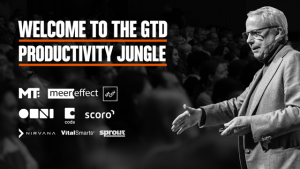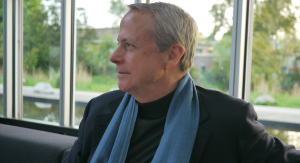David Allen's Blog, page 35
May 6, 2019
Building a Productivity Jungle
 The GTD Summit kicks off in just seven weeks!
The GTD Summit kicks off in just seven weeks!
We are in the midst of finalizing our program and I am excited to announce that Emily Gregory of VitalSmarts will be joining our incredible lineup. She’s going to be sharing insights on effectively managing 10,000+ people.
As well as our stage content, we have been working on an exciting part of the event that we’re calling the “Productivity Jungle.” There you’ll be able to meet 12 curated companies demonstrating their innovative productivity apps, project management tools and newest educational programs.
Among those companies are Coda.io, Scoro, Meereffect, OmniFocus, NirvanaHQ, and many more that we’ll be announcing over the next weeks.
As always, check out the full lineup as well as our complete roadmap to help you plan your two days. Prices go up again on May 10th—don’t miss out.
See you there!
The post Building a Productivity Jungle appeared first on Getting Things Done®.
April 18, 2019
Technology and Productivity
 How does technology affect your productivity?
How does technology affect your productivity?Despite my thirty-five years of consulting, coaching, and training in hundreds of organizations, I don’t have an easy answer to that question. The digital tools we need and like require more intensive labor than they should. It would be great to have a digital dashboard that integrated all apps, allowed you to manipulate information in a single location, and then sent the revised data back to its original location. And all upgrades would happen automatically! Doubtful, in my lifetime.
In the meantime, we have to make the tools we have work as best we can. Imagine your workspace is like your kitchen, with tons of different gadgets and tools that serve different purposes. You can gain a lot of clarity just by making sure you regularly clean and organize your kitchen (and digital ecosystem). You can go a step further by discarding out-of-date hardware (and software)—to keep your “cockpit” streamlined.
The digital revolution
The digital revolution didn’t necessarily make work simpler; it just speeded up processes and introduced a zillion creative options. And its tools require constant upgrading.
Keeping all of that straight in your own life is challenging enough. But when you add to that the technologies that teams and organizations incorporate to try to become more productive, which you may be required to use, frustration can dramatically increase.
Shared technology
Problems with shared technology usually arise because (1) the formulas and protocols about how to use the applications are not well defined, and/or (2) not everyone plays appropriately, so the data is incomplete or unreliable. This is particularly true with shared software for project status tracking. And if the system is not 100% trustworthy, it doesn’t serve you well or save you time. Same goes for the team and the organization.
Staying on top of your workflow
To stay on top of this game you need to integrate the GTD methodology so you appropriately engage with all potentially meaningful inputs in your life, and learn how to use your digital implements like a master chef. And find some savvy twelve-year-old to be your digital consultant! If you can get all that on “cruise control,” you’ll recognize it’s a great time to be alive.
–David Allen
This essay appeared in David Allen’s Productive Living Newsletter. Subscribe for free here .
The post Technology and Productivity appeared first on Getting Things Done®.
April 15, 2019
Episode #49: David Allen Talks with Nancy Duarte and Patti Sanchez
Join David Allen for an intriguing discussion about leadership and the architecture of story, with Nancy Duarte and Patti Sanchez. They came to fame when they created the presentations that Al Gore used in speeches for several years before An Inconvenient Truth won the Academy Award for best documentary. Their book is Illuminate, “a road-map to help leaders move people to embrace bold visions and carry them forward.” They describe five phases of an organization’s story, and how leaders need to communicate to inspire progress. The team at Duarte have also been a trusted resource for David Allen Company in the storytelling involved with our GTD curriculum.
Subscribe or Download to GTD Podcasts
iTunes
Stitcher
Libsyn
Google Play Music
Spotify
SoundCloud
The post Episode #49: David Allen Talks with Nancy Duarte and Patti Sanchez appeared first on Getting Things Done®.
April 9, 2019
Make it up and make it happen
 There are only two problems in life.
There are only two problems in life.Isn’t that nice to know? You only have two things you ever need to be concerned about. Not only are there only two problems—they are really quite simple. Ready?
Problem #1: You know what you want, and you don’t know how to get it.
Problem #2: You don’t know what you want.
Anything you can define as a problem can be reduced to one or both of those statements.
Now, since there are only two problems, it follows that there are only two solutions that you will ever need. You need to make it up, and make it happen. You must decide and clarify what outcome you’re after; and you must then determine how you get from here to there.
The two sides of your brain
It turns out that those two issues match the two sides of your brain. The “make it up” part relates to the right hemisphere—the imaging, gestalting, creative part of our thinking. The “make it happen” part is identified with the left side—the linear, logical, figure-it-out aspect.
Another way to understand this polarity is that if you know what you want and where you’re going, efficiency is your only improvement opportunity. Getting there with less effort is the name of your game. If, however, you’re not so sure where you’re headed or what it is exactly that you’re after, your challenge is to identify and sharpen the image, the outcome, the goal.
GTD fundamental thinking process
This dual nature of our work and our world connects with the two key questions of what we refer to as the “fundamental thinking process”—What’s the desired outcome? And, what’s the next action? Those are the two questions that must be asked and answered by any of us, to determine what any of our “stuff” means to us. What do I do with this email, this piece of paper, this thought I had driving home? What outcome, if any, am I now committed to about it? What’s the next action required to move it toward that outcome? Those questions are normally answered for us or self-evident, except in a crisis. Usually we have to, in a sense, make something up (decide what we’re committed to) and make it happen (choose a next physical action to move forward on it).
Welcome to “knowledge work athletics.”
So, which question do you need to answer, about what, at this point? Where do you need to put some more mental horsepower into figuring out what you’re trying to accomplish, at what horizon? And on which things do you still need to challenge yourself and others to decide the next actions to take, and who’s going to take them?
You can’t manage time
Time management? No, you can’t manage time. It’s thought management. You must lasso the wild horse of your mind with the two critical aspects of a successful ride—direction and control. Make it up, and make it happen.
–David Allen
The post Make it up and make it happen appeared first on Getting Things Done®.
March 22, 2019
Closing the Loops on Meeting Notes
 I’m often asked about the best practices for taking meeting notes, including how to process them after the meeting. Here are some tips and suggestions that I hope will be useful to you.
I’m often asked about the best practices for taking meeting notes, including how to process them after the meeting. Here are some tips and suggestions that I hope will be useful to you.
Capturing ideas, relevant information, etc. during meetings is important so that you don’t have to rely on your brain to remind you about them later. How best to capture that information is purely a personal preference – some people like to use electronic note-taking devices, some people prefer pen and paper.
Regardless of which tool you use, keep in mind that taking notes during meetings is just “collecting”, and the notes will need to be processed just like any other input – email, paper, etc. It would be one thing if we returned to our desk from a meeting and could say with 100% certainty that EVERYTHING we wrote down during the meeting was reference info that could be filed immediately. But what happens of course, more often than not, is that what’s captured: 1) doesn’t necessarily have anything to DO with the actual meeting, 2) is a mishmash of info that popped into our head during the meeting, and/or 3) is an amorphous mix of next actions, mixed with reference info, mixed with doodles!
Here are some suggestions for “closing the loops” with meeting notes:
1. Just as with any capture tool, you want to have as many as you need but no more than you need. Try to have just one or two notebooks that you actively use. It’s much easier to process and organize when you have one notebook, versus having multiple ones.
2. Always date stamp the notes. You don’t want to waste time going back to your calendar to determine when the meeting took place.
3. When processing your notes, go one page at a time, looking for next actions, projects, reference info, ideas, etc. Organize them (manually) into their appropriate places in your trusted system.
4. If you don’t have time to process the notes immediately after the meeting, tear them out of your notebook, toss them into your inbox, and process them within 24-48 hours of the meeting. (Trust me, the abbreviations and scribbles will be much easier to decipher.) If you’re using an electronic note-taking tool, either print the notes out and toss them into your inbox, or write a hand-written note that says “process notes from 8.28 meeting” and put that into your inbox.
5. Ideally, after the notes have been processed, they either get filed if you need/want to keep them, or they get tossed. If you use a spiral notebook and have resistance to tearing the pages out (you know who you are!), take a pen and draw a line through the pages that have been processed. That way your brain doesn’t feel like it has to re-process the notebook from beginning to end.
Doing these behaviors consistently will alleviate having a backlog of notes (and notebooks!) to process later.
Julie Ireland is a GTD Coach with GTD Focus, the certified partner for coaching in the U.S.
The post Closing the Loops on Meeting Notes appeared first on Getting Things Done®.
March 15, 2019
Completing and Creating
 Seems that we’re here on the planet to learn about and do two things—complete and create. We are responsible for what we have put into motion on all levels, and we must manage the process of what we are putting into motion every moment.
Seems that we’re here on the planet to learn about and do two things—complete and create. We are responsible for what we have put into motion on all levels, and we must manage the process of what we are putting into motion every moment.
I work with people and organizations about both aspects. Complete means getting control of all those things into which we have invested our attention and commitments. The create part is the proactive process of focusing our energies toward more expanded and positive expressions and outcomes.
Though both aspects are primary, I think a lot of people could use a good bit more emphasis on the complete part. Our cultural personality seems bent on limitless expansion and not necessarily cleaning up after itself. Consider on a macro scale how we’re dealing (or more critically, not) with climate change and our roles in that.
In one of my more sublime enlightenment moments many years ago, I got a message loud and clear that I needn’t be so concerned about “what to do with my life.” I had already created so much that all I had to do was deal with what was present in front of me to the best of my ability, resolving it as quickly and cleanly as possible. The conveyor belt of life would just deliver the next experience in the queue, as soon as I had dispensed with the last one. It’s been good advice.
When I work with people to get closure and completion on all their “stuff” lying around their desk, in their email, and on their mind, without exception I’ve watched significant creative energy burst forth in them. It seems to be a natural state for us, when we clean up the kelp on the keel.
-David Allen
This essay appeared in David Allen’s Productive Living Newsletter. Subscribe for free here .
The post Completing and Creating appeared first on Getting Things Done®.
March 14, 2019
New GTD & Google Apps Setup Guide
 We’ve updated our GTD® & Google® Apps for Desktop Setup Guide to work with the latest versions of Google Tasks™, Google Keep™, Gmail™, and more. If you passed over Google Tasks in the past because of its limited functionality, the new version is much more user-friendly and functional. Download or see a sample.
We’ve updated our GTD® & Google® Apps for Desktop Setup Guide to work with the latest versions of Google Tasks™, Google Keep™, Gmail™, and more. If you passed over Google Tasks in the past because of its limited functionality, the new version is much more user-friendly and functional. Download or see a sample.
This Guide will show you how to:
– Understand the fundamental GTD best practices
– Optimally configure Google Apps in the way we have found works best for GTD
– Integrate your actionable email and how to turn email into Tasks
– Create project and next actions lists in Google Tasks or Keep
– Create useful reference lists in Tasks, Keep, or Drive
– Use shortcuts to speed up your workflow
… and much more!
PDF Download (39 pages)
The post New GTD & Google Apps Setup Guide appeared first on Getting Things Done®.
March 11, 2019
Episode #48: Installing GTD in an Organization
Jason Atwood has built Getting Things Done into his company from the start. Listen as he shares with David Allen about starting Arkus, a Salesforce consulting firm, well after his own GTD practice was on a solid foundation. Beyond encouraging his employees to adopt GTD, he provides them with ongoing tools and support. During the onboarding period, he even meets with new employees to answer questions and refine their GTD implementation.
Subscribe or Download to GTD Podcasts
iTunes
Stitcher
Libsyn
Google Play Music
Spotify
SoundCloud
The post Episode #48: Installing GTD in an Organization appeared first on Getting Things Done®.
March 6, 2019
News on GTD Setup Guides
Looking for the best coaching advice on getting GTD® setup in your favorite tool? Check out our popular GTD Setup Guides. They are written by our GTD experts and are packed with step-by-step instructions and advice on how to get the most out of many common tools for Getting Things Done®.
We currently have GTD Setup Guides for:
Outlook® for Windows®
Outlook® for Mac®
Nirvana®
Trello®
Google® Apps
OmniFocus®
Todoist®
Evernote® for Windows
Evernote® for Mac
OneNote® for Windows
iPhone®/iPad®
Lotus Notes®
Things®
Wunderlist®
Paper Organizers
You can find them all in our GTD Shop, including free samples to get an idea about what’s of the content. Monthly and Annual GTD Connect members can download Setup Guides for free on gtdconnect.com.
We are working on an Asana® guide now and will post more news on that when we are closer to releasing it. We are also updating our Google Apps Guide and Outlook 2019 for Mac, as they UI and features changed significantly on both.
We can’t create guides for every tool out there, but we’re always open to suggestions for what you’d like to see!
The post News on GTD Setup Guides appeared first on Getting Things Done®.
February 25, 2019
Two themes for the GTD Summit
The global GTD Summit we’re organizing for this coming June has two primary themes, neither of which is about working harder or longer, or motivating yourself in any kind of “rah, rah!” way. They are:
The strategic value of clear space, andThere are no problems, only projects

In my experience the essential aspects of being in a productive state are having a clear head and being appropriately engaged with the object of your attention and focus. In other words, being truly present and in the driver’s seat of your life and work situations.
Headlining our event with “turbocharge your productivity” may seem incongruous with what I’ve just written about our content. But virtually every one of our 40+ presenters will express and demonstrate the kind of dynamic (and productive) results that are produced by one or both of our two themes.
Whether it’s Dr. Julie Flagg talking about the lives she’s saved through applying GTD in her OB/GYN practice, Dean Acheson elaborating on the organizational changes facilitated by identifying and clearing up “open loops,” Robyn Scott sharing how these practices impact significant NGO initiatives, or Mark Wallace telling stories of kids applying GTD in his elementary school classroom, there will be common perspectives that can be applied by any of us, any time, in our own meaningful endeavors.
But we don’t seem to be born inherently applying the core principles of Getting Things Done®. They have to be learned and made habitual to really “turbocharge your productivity.” And even though the methodology may already be understood and to some degree applied, if you’re like me you can consistently use reminders of how to take things to a new and more elegant level.
The Summit will be a feast of such.
Learn more at www.gtdsummit.com
The post Two themes for the GTD Summit appeared first on Getting Things Done®.
David Allen's Blog
- David Allen's profile
- 1479 followers



